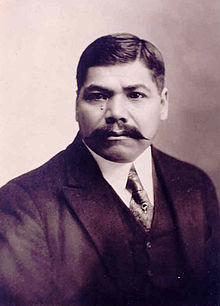Genovevo de la O
This article includes a list of general references, but it lacks sufficient corresponding inline citations. (January 2010) |
Genovevo de la O | |
|---|---|
 De la O in 1913 | |
| Governor of Morelos | |
| In office 12 August 1914 – May 1915 | |
| Preceded by | Pedro Ojeda |
| Succeeded by | Lorenzo Vázquez |
| Personal details | |
| Born | 3 January 1876 General |
| Battles/wars | Mexican Revolution |
Genovevo de la O (January 3, 1876 – June 12, 1952) was an important figure in the Mexican Revolution in Morelos.
He was born in
Early life
From his earliest days, de la O stood out as a defender of his hometown and its people. He fought ceaselessly against the encroachments of the neighboring
He initially supported the presidency of
Revolution under Zapata
The Madero government was opposed to the Plan de Ayala, and the Zapatistas took up arms to defend their cause. De la O was made an infantry captain conducting guerrilla operations for Zapata in the northern part of Morelos. He moved up through the ranks of major, lieutenant colonel, and colonel before the year was out.
Through 1911 and 1912, his division of the Liberation Army of the South operated in the area around Santa María and its neighboring towns, consistently beating back federalist forces. He forced enemy divisions to retreat to Cuernavaca, gave a solid drubbing to a group of generals led by General Robles, and inspired thousands to flock into his division.
De la O's forces took the town of Huitzilac in the Spring of 1912, but the Federalists were reluctant to give it up. General Ojeda tried to evacuate the town’s supplies and equipment, but de la O exacted a heavy toll attacking the convoys. He defended the town with success, but in 1912 General Naranjo infiltrated and burned most of it to the ground.
As 1913 neared, he pushed into
Revolution under Obregón
Rather than seeing his cause and power expire along with Zapata, de la O and the other guerrilla generals, led by Gildardo Magaña, joined forces with the new revolutionary Álvaro Obregón. In 1920, he covered the retreat of General Benjamín Hill from Mexico City, and Hill too united with Obregón’s forces in the south. Together they made a decisive strike at the capital city, deposed Carranza, and set up a new government.
On the first day of 1921, he was named chief of military operations in Tlaxcala, moving later to similar posts in Aguascalientes and Mexico City. Minor conflicts continued, but the Obregón regime, including de la O, remained in power in Mexico City.
Post-Revolution politics
De la O held political posts until 1941 when he reached the age limit for service (sixty-five) and was forced to retire. Though officially retired, he remained involved in the affairs of Mexico. He formed
He died in peace while in his hometown of Santa María Ahuacatitlán, a gentler and later death than the vast majority of his revolutionary counterparts. His wake was held on the floor of the
See also
- Mexican Revolution
- Emiliano Zapata
- List of people from Morelos, Mexico
References
- ^ Genovevo de la O accessed Dec 28, 2018
External links
- Personal biography in Spanish
- Factual biography in Spanish with extensive battle descriptions
- Corrido de Genovevo de la O[permanent dead link], a Spanish ballad about his exploits.
